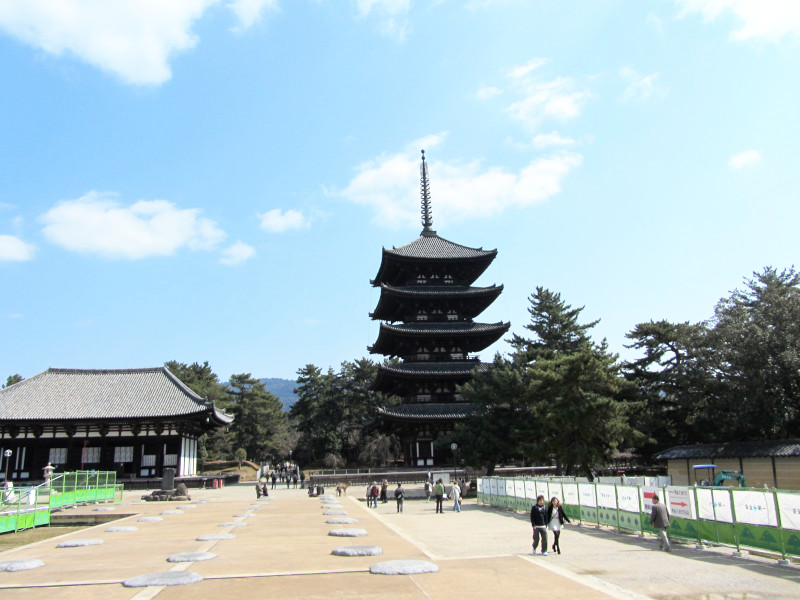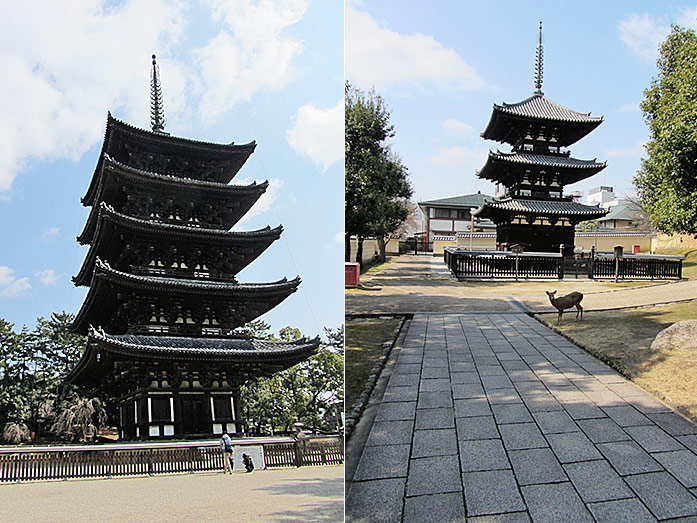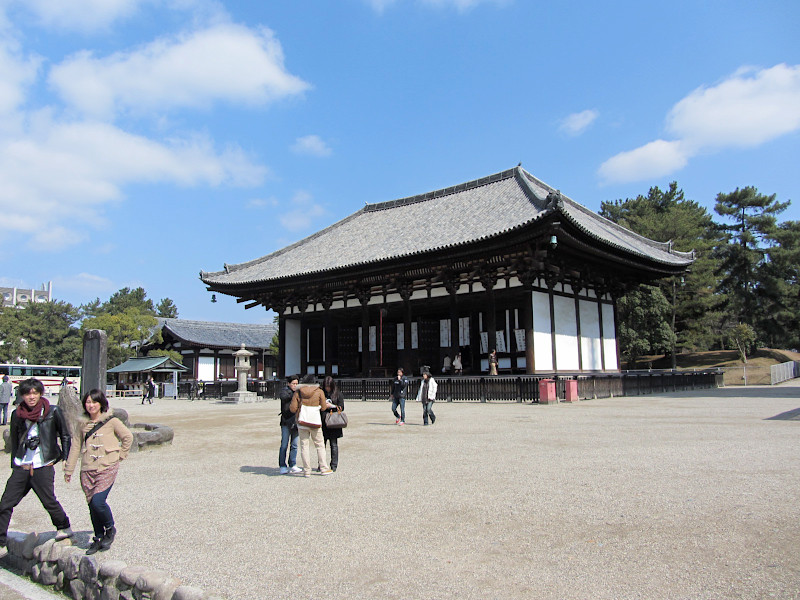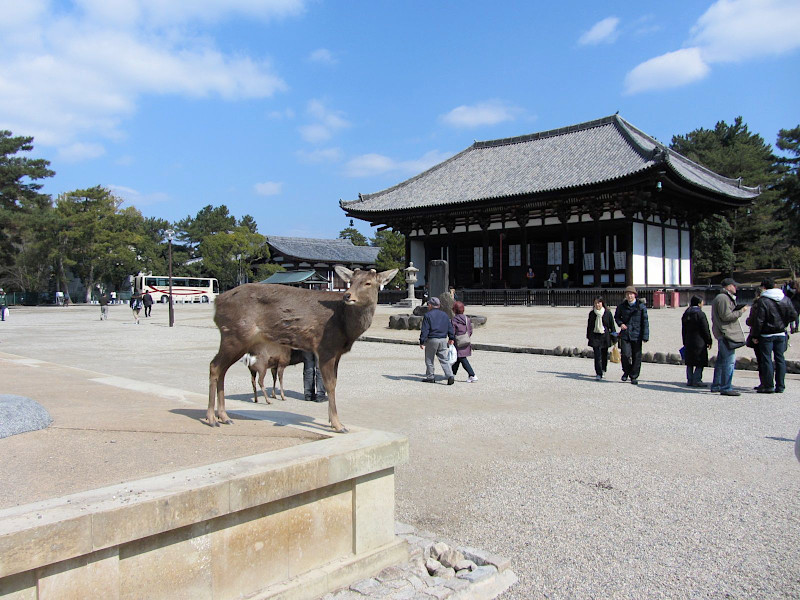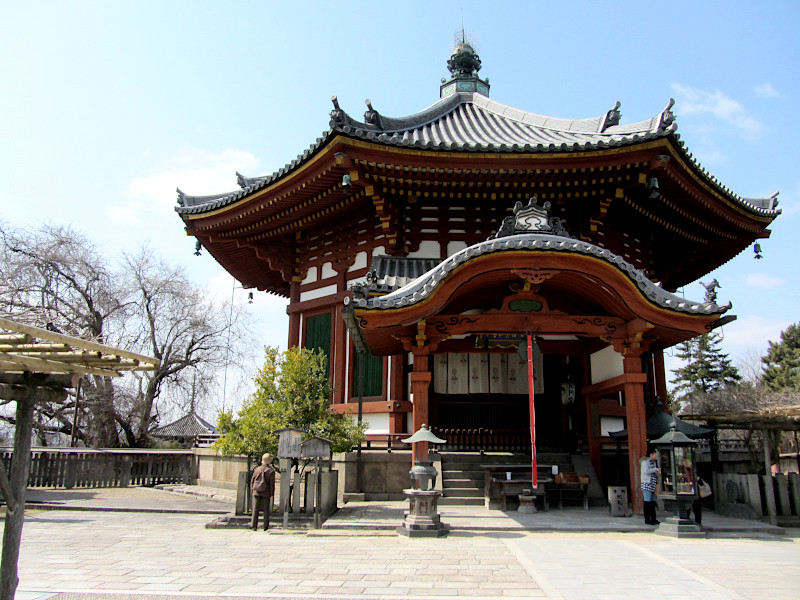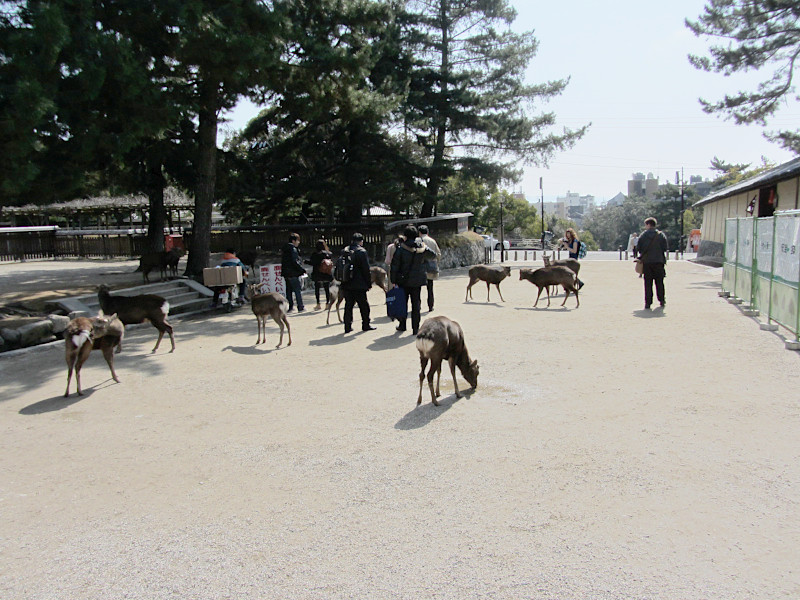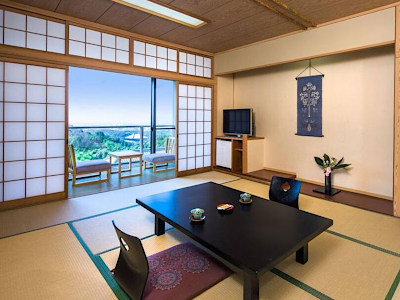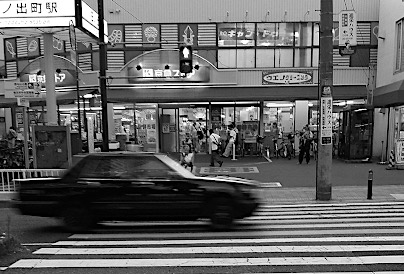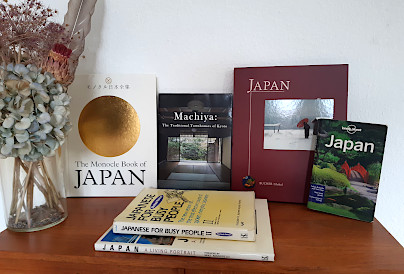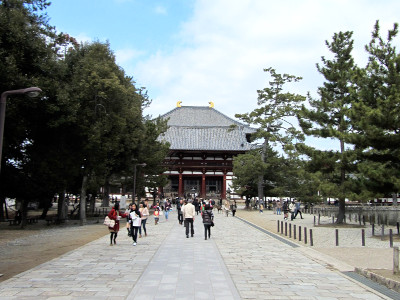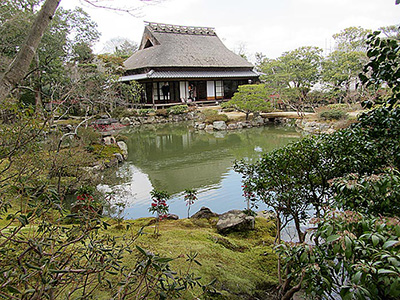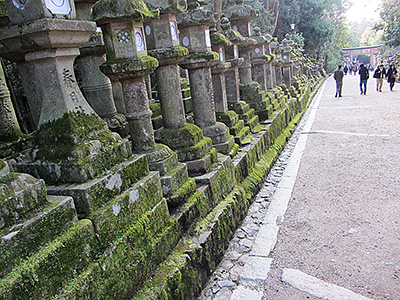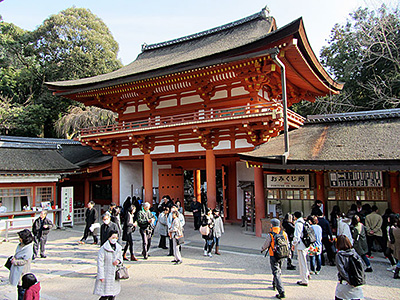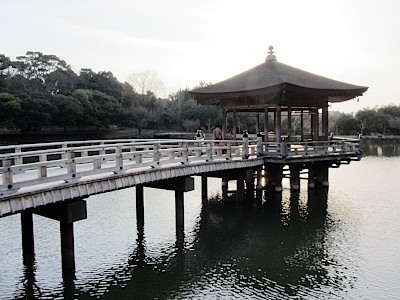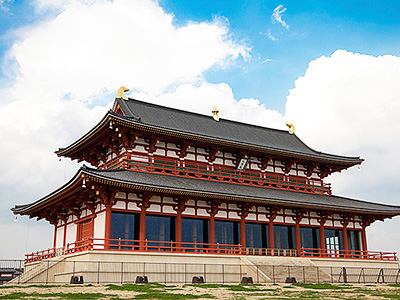Kofukuji Temple in Nara
This post can contain affiliate links, which means that we may receive a small commission if you make a purchase using these links.
Facts & Figures
The Kofukuji Temple complex with a history of over 1300 years belongs to the Seven Great Temples of Nara. In 1998 the Buddhist temple was named a UNESCO World Heritage Site. The temple complex is part of the eight "Historic Monuments of Ancient Nara" on the UNESCO World Heritage List and includes two pagodas. Four buildings of Kofukuji have the status of national treasures and these are the Five-Story Pagoda (Goju-no-to), Three-Story Pagoda (Sanju-no-to), Tokondo (Eastern Golden Hall), and Hokuendo (Northern Octagonal Hall).
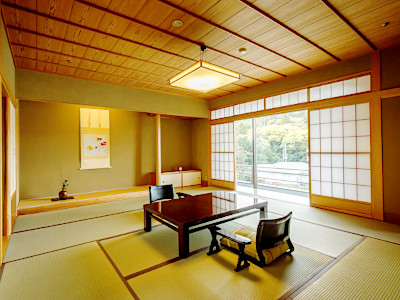 Explore Ryokans in Nara >
Explore Ryokans in Nara >
Ryokans are the perfect way to discover old Japanese culture and traditions.
The Three-Story Pagoda is located on the west side and the Five-Story Pagoda is on the east side. The Five-Story Pagoda is with 50.1 meters the second highest pagoda in Japan and a symbol of Nara. The tallest pagoda can be found at the Toji Temple in Kyoto. Other important sightseeing spots are the Kofukuji National Treasure Museum (Kokuhokan), Nanendo (Southern Octagonal Hall), and the Central Golden Hall (Chukondo). Kofukuji Temple is also the national headquarters of the Hosso School of Buddhism. During your visit, you will have many encounters with freely roaming deer. These are considered sacred as they came from Takemikazuchi-no-mikoto, which is one of the four gods of the Kasuga Shrine.
- The Eastern Golden Hall:
- Opening Hours - 9:00 am to 5:00 pm (all year)
- Admission fee (cash only) - 300 yen (Adults), 200 yen (High school students), 100 yen (Primary school students)
- The Central Golden Hall:
- Opening Hours - 9:00 am to 5:00 pm (all year)
- Admission fee (cash only) - 500 yen (Adults)
- The Kofukuji National Treasure Museum:
- Opening Hours - 9:00 am to 5:00 pm (all year)
- Admission fee (cash only) - 700 yen (Adults), 600 yen (High school students), 300 yen (Primary school students)
My tips for local activities
How about exploring the highlights and hidden gems of the fascinating city Nara with a local guide. Check out this page > for more details.
History
Kofukuji Temple was originally located in Kyoto and known as Umayasaka-deraand. The construction of Kofukuji was finished in 669. The temple was moved to Fujiwara-kyo in 672. In 710 the temple was moved for the second time to its current position in Nara, a former capital of Japan from 710 - 794. It was the temple of the influential Fujiwara family, a powerful clan of regents during the Nara (710 - 794) and Heian Period (794 - 1185). They became the dominant political force in the region. In the past, the temple consisted of more than 150 buildings and covered most of what is known now as Nara Park. During the Meiji Period (1868 - 1912) most of the temple grounds were confiscated due to anti-Buddhist policies and there are now only 11 remaining buildings. Nearly 300 years ago the main temple hall of Kofukuji, also called the Central Golden Hall, burnt down completely. But here comes the good news in October 2018 the long reconstruction phase was over and the Central Golden Hall was open for the public again.
Location

The Kofukuji Temple complex is located near Kintetsu Nara Station within the Nara Park and next to the Nara National Treasure Museum.
Address: 48 Noboriōji-chō, Nara, Nara Prefecture
How to get to Kofukuji Temple?
- 7min from Kintetsu Nara Station served by Nara and Kyoto Line or
- 20min from JR Nara Station served by Yamatoji, Nara, Gakkentoshi, Sakurai Line or
- 6min from JR Nara Station by bus to Kencho-mae stop
Sightseeing spots
Top:
Eastern Golden Hall (Tokondo) - The hall was built in 1415 and contains a large statue of Yakushi Buddhaoverall surrounded by three Boddhisattva, a seated image of the Indian Buddhist sage Vimalakirti (Yuima Koji), Four Heavenly Kings (Shitenno) and the Twelve Heavenly Generals (Junishinno).
Central Golden Hall (Chukondo) - The reconstruction of the building was completed in 2018 after it burned down in 1717. It serves now as the temporary Lecture Hall. For now, the building is not open to the public.
Five-Story Pagoda (goju-no-to) - The current building/pagoda was constructed in 1426. It is after Kyoto's Toji Temple Pagoda the second tallest pagoda (50.1m) in Japan. Important: From July 2023 until March 2031 the Five-Story Pagoda is undergoing extensive renovation work and will be covered up during this time.
Three-Story Pagoda (sanju-no-to) - The pagoda dates back to the beginning of the Kamakura period 1185 - 1274. You will find there an exhibition of important Buddhist paintings.
Northern Octagonal Hall (Hokuendo) - It is a reconstruction of the original building from 1210. Hokuendo was built to honor the first anniversary of the death of Fujiwara no Fuhito (659 - 720), a very powerful member of the imperial court of Japan.
Southern Octagonal Hall (Nanendo) - Nanendo dates back to 813. The current reconstruction was finished in 1789. The hall is number nine of West Japan's famous thirty-three temple pilgrimages route.
Kofukuji's National Treasure Museum - If you love Buddhist art this is a must-see. You will find there a collection of the best Buddhist carvings in Japan. The absolute highlights are the Ashura Statue (one of the Buddha's 8 protectors) with 6 arms and 3 faces, one of the most famous Buddhist statues in Japan, and the bronze head of the Healing Buddha (Yakushi Nyorai).
Omido - Omido is known as "Hall of Thirteen Bells". The building is dating back to 1580.
Fudo Hall - Fudo Hall was built during the Meiji era. It contains an image of Fudo Myo-o, one of the important deities of Japanese Buddhism.
Bath House (Oyuya) - This Important Cultural Property dates back to the Muromachi era (1333 - 1587). It houses two huge iron cauldrons for heating water and an earthen floor, also called an adobe floor.
Festival & Events (dates can change without notice)
February
Nara Rurie Illumination (5th - 14th)
You can stroll through illuminations from Sarusawa Pond up to Kofukuji Temple in the Nara Park. The lights are on from 6:00 pm to 9:00 pm.
March
Ceremony in Memory of Genjoh (5th)
This event takes place at the main office complex.
April
Buddha's Birthday Ceremony (8th)
Ceremony will be held at the Southern Octagonal Hall.
Life Releasing Ceremony (17th)
Ceremony will be held at the Hitokoto-Kannon Hall.
Manjusri Ceremony (25th)
Event takes place in the Eastern Golden Hall (Tokondo).
May
Takigi Noh (11 - 12th)
Watch great performances of Noh drama at the Southern Main Gate.
July
Benzaiten Festival (7th)
The festival is held at the Three-Story Pagoda (sanju-no-to).
October
Daihannya Ceremony (17th)
This event takes place at the Southern Octagonal Hall (Nanendo).
November
Ceremony in Memory of Jion Daishi (13th)
The Priest Jion Daishi was the forefounder of the Hosso Sect of Buddhism in China. The ceremony is held at Kari-kondo (north of the Central Golden Hall - Chukondo).
Where to stay in Nara?
Day trips from Nara:
My 100 Best Moments in Japan
I have visited Japan nearly every year since 2004. This is my collection of the 100 best moments in my favorite country. Enjoy the pictures and I hope you will start your own journey soon.
Find out more >
Books about Japan
Reading books is a great source of inspiration for me. Check out my recommended list of books about the fascinating country Japan.
My Book recommendations >

